10 Best Shrubs for Winter Fragrance
Any one of these 10 best shrubs for winter fragrance are worth proper consideration. In early 2023, I created a long border at the far end of the garden that was planted with shrubs and bushes that provide fragrance. I carefully selected several plants that will fill the air with their sweet scent during the winter months. The aim was to encourage us to walk all the way through the garden to enjoy their colour and fragrance, at a time when we aren’t particularly keen on venturing outside for too long. I have a high tolerance for wildflowers (weeds) in the garden, so the border never looks terribly tidy in the conventional sense, but I love it anyway.
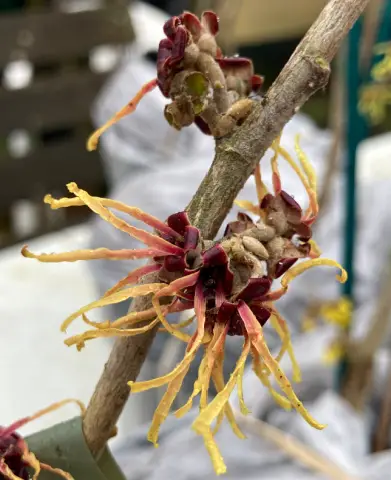
Autumn is the ideal time to plant shrubs for winter fragrance. Plants will have time to settle into the soil before they start flowering and you won’t have to wait too long to enjoy the scents in your garden. But if you missed the autumn for planting, you can still plant pot-grown shrubs at any time of year as long as the ground isn’t frozen or waterlogged.
Sarcococca confusa

Sweet box creates an evergreen, bushy, shrub, 2m height and spread and provides a good display of dark green, shiny leaves. It comes into its own when the small, creamy-white flowers appear, tucked in neatly against the stems. Sarcococca are strongly fragrant and fill the air around the plant with a sweet, floral scent. The flowers are followed by berries which are purely ornamental and should not be eaten. Grow in full shade or partial shade for best results.
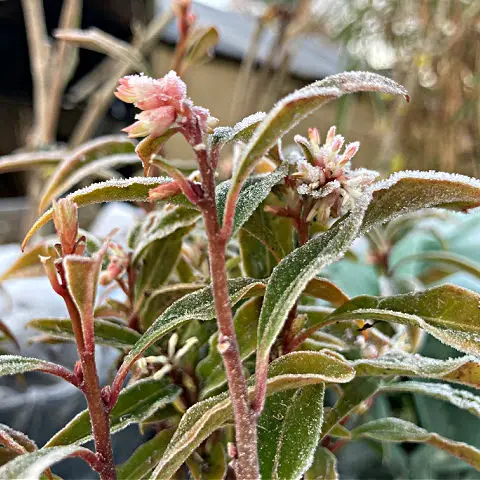
For a slightly different flower, try Sarcococca hookeriana var. digyna ‘Purple Stem’, which has red with white flowers.
Lonicera fragrantissima
Winter-flowering honeysuckle can be a bush or an untidy climber to around 2.5m height. As one of the flowering shrubs for winter fragrance, it is an unfussy plant, tolerating most soil types, will thrive in full sun and partial shade and grows in exposed or sheltered situations. The small white, very fragrant flowers appear during winter and spring, followed by inedible berries during the summer. Great for growing on a sturdy trellis to create a screen to hide an unsightly corner or shed.
Skimmia japonica ‘Fragrant Cloud’
A compact evergreen plant with aromatic leaves. Height and spread 1.5m. Although the tiny bell-shaped flowers do not open until spring, I think it’s worth growing for the leaves and the fragrance of the flowers is worth the wait! They smell similar to lily of the valley. Skimmia japonica ‘Fragrant Cloud’ grows best in an acid soil or pot with ericaceous compost and will tolerate shade and windy site. If growing in a pot, try placing it near the front door, so you can enjoy the scent each time you walk past.
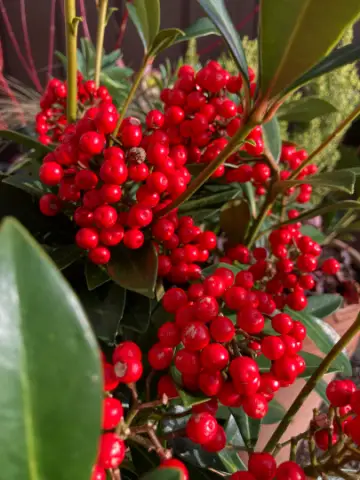
For a bright berry display in winter, try Skimmia japonica ‘Red Riding Hood’. This photo was taken at Aberglasney Gardens in early February.
Chimonanthus praecox
The structure of Wintersweet can look a bit busy, almost scruffy, once the leaves have fallen in autumn. But it doesn’t take long to discover the true attraction of this plant. During the winter months, yellow flowers appear on the bare stems and they are highly fragrant. Height 2.5m – 4m and 1.5 – 2.5m spread. Chimonanthus praecox tolerates most soil types, and prefers a well-drained, sheltered position. The dark green leaves make a good backdrop to other flowering shrubs during the summer season.
Mahonia x media ‘Winter Sun’
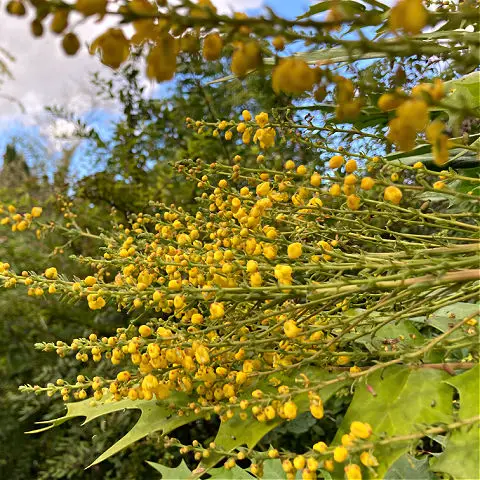
Among my favourite flowering shrubs for winter fragrance is Mahonia. ‘Winter Sun’ as it has upright growth taking up a little less space than some more lax varieties. It grows to 2.5m – 4m height and 1.5m – 2.5m spread. The leaves are spiny, so it is not one to grow too near to the edge of a path. It is relatively unfussy and easy to grow, preferring full or partial shade. During winter arching racemes of bright yellow, fragrant flowers appear above the leaves. The scent reminds me of honey. Berries are inedible.
Viburnum bodnantense ‘Dawn’
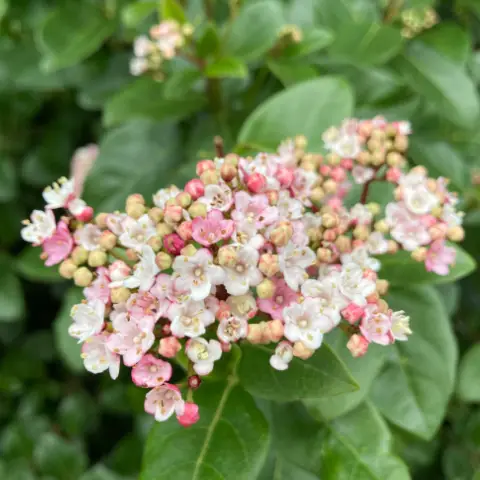
What a joy to see some pink flowers during the cooler months! This Viburnum can flower from late autumn right through to spring, producing flowers on bare branches. It is unfussy about soil and situation, and as long as the position is not water-logged it should thrive. Viburnum bodnantense ‘Dawn’ is hardy throughout the UK and its ease of growing makes it a popular choice. Height 1.5m – 2.5m and spread 1m – 1.5m.
Daphne
This group of plants has a reputation for their sweet smelling flowers and rightly so! I find Daphnes difficult to grow in our very wet, clay soil on an exposed north-facing hillside. But if you can provide the right conditions, Daphne will reward you with a wonderful display of flowers.
Daphne odora ‘Walberton’ (v)
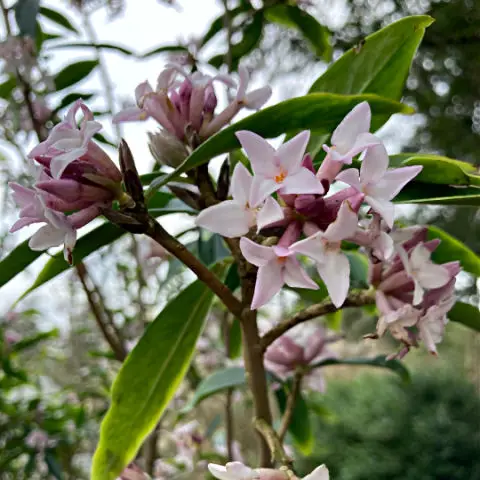
Daphne bholua ‘Jacqueline Postill’
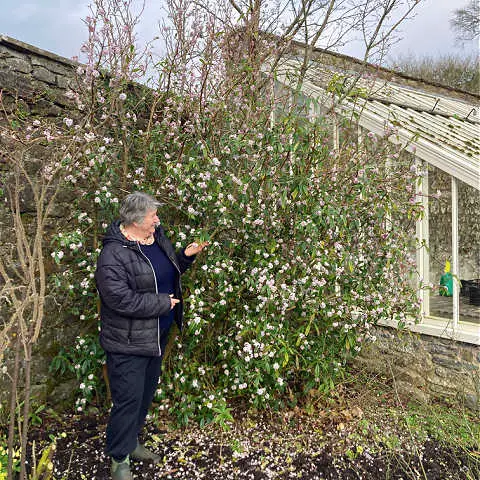
You can detect Daphne bhoula ‘Jacqueline Postill’ before you see it from the sweet scent that surrounds the plants when in flower.
Daphne laureloa
Less showy, but just as fragrant, Daphne laureola grows to 1m height and 1.5m spread. It has dark green, shiny leaves and during winter produces greeny-yellow, fragrant flowers, followed by inedible berries. This variety is relatively unfussy about soil and situation, even growing in shade. It is hardy across most of the UK, even in severe winters. However, it may fail to thrive if the soil is not well-draining and it is an exposed, windy position.
Coronilla valentina subsp. glauca ‘Citrina’
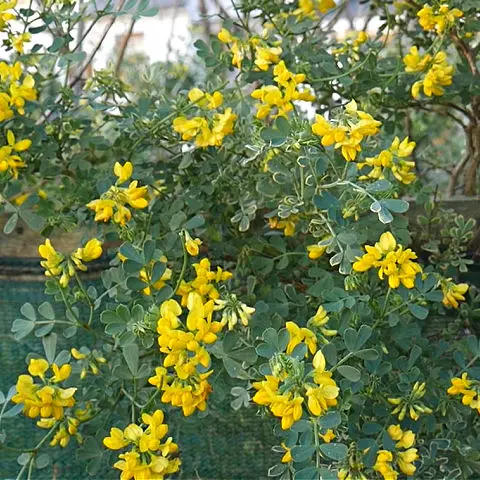
This lovely climbing shrub was in our previous home when we moved there. I hadn’t seen it before, but came to value its cheerful yellow flowers during the coldest months of the year and the lemony floral fragrance that could be detected from several feet away! Usual height 1m, although our plant reached over 1.2m, and 1m spread. The interesting leaves are a blue-grey green and as an evergreen shrub, they provide interest all year round. Coronilla valentina subsp. glauca ‘Citrina’ requires full sun and a sheltered position and is hardy across most of the UK. It may struggle in temperatures below -10C, but ours survived ‘the beast from the east’ of 2018 without difficulty.
Hamamelis or witch hazel
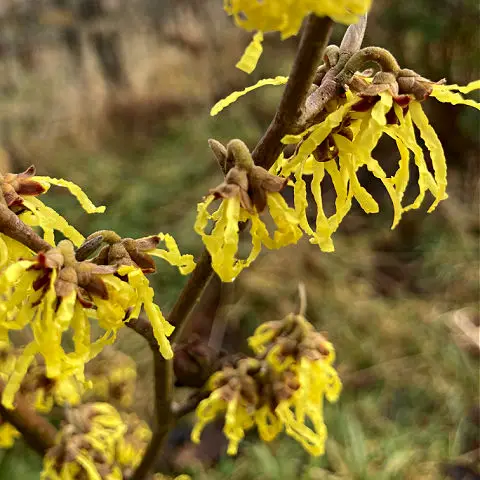
Witch hazels may be well-known, but I think they may be undervalued for their potential contribution to the garden. During summer, the shrubs have green leaves that provide a backdrop for other flowers. In autumn, leaves colour before falling and in winter and early spring, they provide colour from flowers with ribbon-like petals. Hamamelis mollis (above) has fresh yellow flowers, but other colours are available. Ans more important than the colour of the flowers is the fragrance that fills the air around the plants. If you have the space to include more than one plant in your garden, try different varieties for an extra splash of colour interest.
Hamamelis Magic Fire
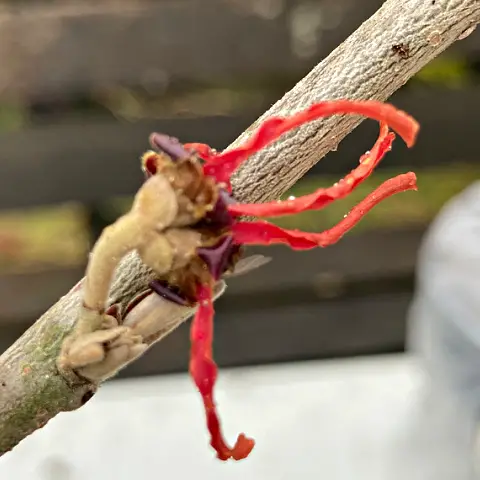
‘Magic Fire’ has bright orangey-red petals.
Hamamelis Jelena
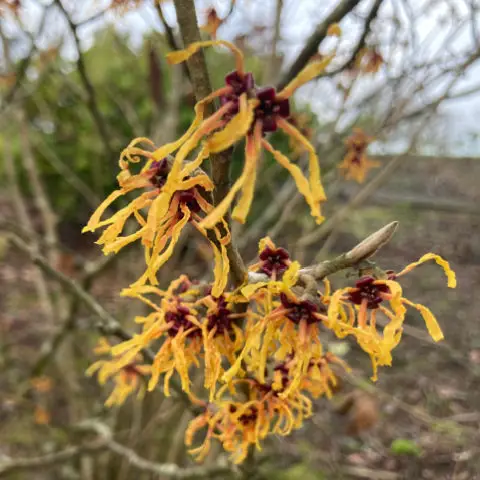
‘Jelena’ has red and yellow flowers.
Hamamelis Diane

Hamamelis ‘Diane’ has rich red flowers.
Edgworthia chrysantha
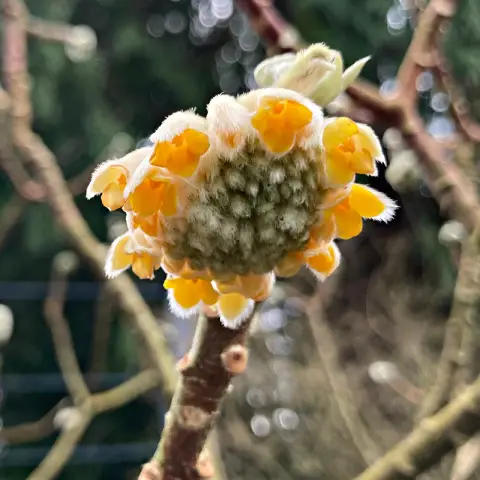
I chose this plant not only for its fragrance, but for the shape and form of the plant to add interest in the border. During the winter, clusters of yellow fragrant flowers appear on the tips of the bare stems. Related to Daphne, it needs a loamy, well-drained soil in full sun or partial shade. It is unlikely to thrive on a north facing site (but I still wanted to give it a try) and requires a sheltered position. It is not as hardy as some of the other choices, but is hardy across most of the UK (-5C to -10C). If you can provide the right conditions, Edgworthia chrysantha will be relatively pest and disease free.
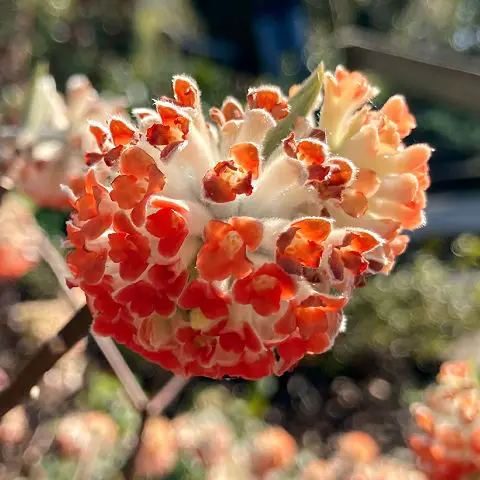
For an orange flower, try Edgeworthia chrysantha ‘Red Dragon’.
Thifty tip
Cut a few stems of more mature shrubs and use to create supports for autumn flowering herbaceous plants. If left in place over the winter, they may root and can be lifted in spring and moved to a permanent position.
More information
I regularly write for Amateur Gardening magazine and have written about fragrant plants for the winter garden. Links are included in this article to help you find the suggested plants.
For information about what to do in January, check out the Vegetable Garden in January.
- Baby pepper inside pepper | Strange vegetable - September 16, 2025
- Biennials to sow in June and July - September 12, 2025
- Protected: Urban back garden - August 28, 2025
